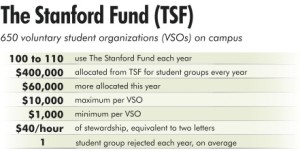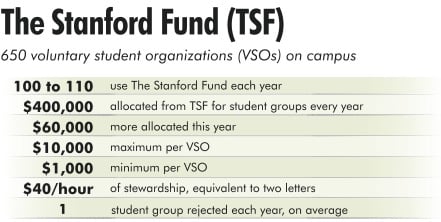
The Stanford Quiz Bowl Team forgot to submit an application last spring to request money from The Stanford Fund, a fundraising program that sets aside $400,000 of its earnings each year to support on-campus student organizations.
But this fall, the team will have a second chance to apply.
This is because Student Activities and Leadership (SAL), the body responsible for allocating this pot of money to different student groups, announced in an email to club leaders on Monday that it would be holding a second round of applications. At the end of last spring quarter, President John Hennessy approved a request to increase the amount of money allocated to student groups from The Stanford Fund (TSF) by approximately $60,000.
Student organizations are allowed to apply for these additional funds by Oct. 22 if they happen to meet one of three criteria: They did not apply for funding last spring, they had their funding request rejected last spring or they received funding but are currently facing extenuating or unforeseen circumstances that require additional funding.
While the Quiz Bowl Team often finances its operations by holding tournaments for high school students and charging an entrance fee, the group’s president, Kyle Sutherlin, a graduate student in chemistry, said the extra money could help them fund traveling expenses for out-of-town competitions.
“We would survive without it,” Sutherlin said, “but it would be helpful.”
Extra funds requested
TSF is an annual fundraising campaign that collects gifts from alumni and University community members. All money raised is spent under the discretion of the University president with the goal of improving the experience of undergraduate students. Most years, the bulk of the money—81 percent in 2010-11—goes toward supporting financial aid packages.
The University, however, allocates another portion of the fund to SAL, which in turn distributes the money to student organizations on campus. According to Felicity Meu, a senior associate director in the Office of Development, this pool of money has sat at the same level—$400,000—for at least the past four years.
“In that time period, we’ve seen a lot of student groups’ costs rise,” Meu said. “So we wanted to make sure the money we had to hand out reflected that increase in cost.”
Meu wrote a proposal to President Hennessy last spring requesting an increase in funds allocated to student groups.
Meu said she was able to make “a strong case” due to the fact that student organizations had successfully used all of the money from this pool in previous years. She also said the amount raised by TSF had grown from the previous year, giving the University extra funds to spare.
At the end of the quarter, Hennessy granted the request.
The news, however, came after the spring deadline for student groups to file for money from TSF for the upcoming academic year. In response, SAL has decided to hold a second application round this fall.
Groups find difficulties meeting requirements
DV8, an on-campus hip-hop dance team, has not requested money from TSF in at least three years. But after hearing news about the additional funds, the group is considering applying this fall.
According to DV8 president Lauren Baker ‘13, the organization has strayed away from TSF in recent years because of the time commitment and full-group participation that accepting funds requires.
Each organization that receives money from TSF must perform stewardship works—one hour for every $40 of funding the group received. Stewardship normally involves writing thank-you letters to donors or staffing University events like Reunion Homecoming Weekend or Parents’ Weekend.
According to Baker, the group has managed to find less time-intensive ways of raising money to support its activities over the years than using TSF. DV8 receives funding from the ASSU appropriations committee and makes revenue from ticket sales.
This year, however, DV8 is looking to expand its program in an effort to grow the hip-hop dance community at Stanford, which will require more funding.
“I would say we’re looking to exhaust other resources before pursuing TSF since it’s a significant amount of work,” Baker wrote in an email to The Daily. “But we’re definitely considering [TSF] as a option.”
She plans to attend one of the workshops student organizations must attend to qualify for funding. The workshops are scheduled to be held in Old Union on Oct. 9, Oct. 11 and Oct. 12, in preparation for the Oct. 22 application deadline.
The goal of these workshops is to determine whether or not a group should apply for money from TSF, according to Nanci Howe, director of SAL.
“This funding program is not for everyone,” Howe said. “It’s kind of like buying a car—some cars are better for some people than others. I think we’re trying to help groups pick the right funding source for the kinds of activities that they do.”
Howe said that a few organizations struggle with meeting the stewardship component, most commonly because they lack an active core group of membership or apply for more funding then they can logistically support. Often the best organizations for TSF, she said, are a cappella groups or club sports teams, because they have large and active memberships.
A student organization president, who was granted anonymity because he did not want to harm his relationship with SAL, said his group has slowly decreased the amount of money it has requested from TSF each year, even increasing club dues by 50 percent this year to make up for the loss in funding.
“For many years, we struggled to comply with all of the TSF requirements (even though we outline them the year before), and it has been a hassle for our club (around 70 members) to do everything each quarter to gain substantial funds,” he wrote in an email to The Daily. “So for this year, we decided to request less and thus have less duties to TSF.”
Baker noted that the program has improved since she has been at Stanford, and it has started allowing groups other options for meeting their stewardship hours, such as volunteering at events or making promotional videos. In fact, many presidents of organizations that received funding were overwhelmingly positive about the program.
“I don’t mind writing letters,” Sutherlin said. “We are getting a lot of money from them, so I think the least we can do is write a few letters to thank them.”
Innovative approach to funds
Ankita Rakhe, assistant director at SAL, will be managing the application process. She expressed hope that holding a second round would help smaller student organizations, especially since groups that have already received funding would not qualify for the additional round.
“It’s really exciting to get a surplus in funding,” Rakhe said. “I’m hoping that there are a lot of student organizations that maybe haven’t applied for [the Fund] before that will come out.”
SAL will release funding results on Nov. 9. The following week, the Office of Development plans on holding individual meetings with each student organization that received funding to discuss how they will fulfill the stewardship requirement.
Approximately 100 student groups receive funding every year, in amounts varying from $1,000 to $10,000. The additional money will probably service 10 to 26 more groups, according to Meu.
Howe, who has been with the program since its inception, called it the first of its kind in the country. She said that other universities have expressed interest in replicating the program at their own institutions because of its innovative way of funding student organizations and making connections between alumni and students.
“I’ve worked at a lot of universities and I haven’t seen this kind of direct student group model anywhere else before,” Meu said. “With the student group leaders that we work with, [funding is] an important area of need on campus, and for us, we are incredibly grateful that the students then turn around and help us say thank you to all of these donors in really meaningful ways.”
